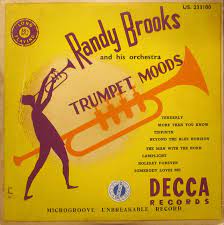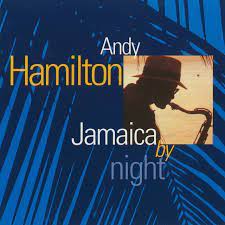
Daily Dose Of Jazz…
Randolph E. Brooks was born on March 28, 1917 in Sanford, Maine and began on trumpet at age six. By 11 he was discovered by Rudy Vallee and appeared on his Fleischman Hour radio show. He became a permanent member where he played thrilling trumpet solos, but was not allowed to play with the brass section of the band. By the time he was eighteen he was working with Jerry Blane for an entire summer in western New Jersey, followed by Gene Kardos and then Ruby Newman at the Rainbow Room in New York City.
Hired by Hal Kemp, he cut his first records for the Victor label in 1939. After Kemp’s death late in 1940, he stayed with the band when Art Jarrett took leadership. But by 1942 he moved on to a brief relationship with Claude Thornhill, followed by Bob Allen, but within a year he was playing with Les Brown before founding his own band in early 1945.
John Benson Brooks, who was not related, contributed arrangements to the ensemble that included Stan Getz in 1946. Among his hits for Decca Records were Tenderly, Harlem Nocturne, and The Man With The Horn, but unfortunately his swing-based style and large ensemble were out of step with the times, and his success eroded toward the end of the decade.
He married singer and bandleader Ina Ray Hutton and moved to Los Angeles, California where he suffered a stroke and was unable to continue as a musician. Trumpeter and bandleader Randy Brooks transitioned at the age of 49 of smoke inhalation in a fire at his Sanford, Maine apartment.on March 21, 1967.
More Posts: bandleader,history,instrumental,jazz,music,trumpet

Requisites
Giant Steps (In Memory of John Coltrane) ~ Tommy Flanagan | By Eddie Carter
This morning’s choice from the library was recommended to me years ago because of my love of piano trios. I finally acquired a copy and am pleased to submit it for your approval. Giant Steps (Enja Records 4022) is a terrific 1982 album that’s a loving tribute to John Coltrane by pianist Tommy Flanagan. The tenor saxophonist composed all the tunes on this date and five of them appeared on his album Giant Steps (1960). Here, he’s working with an outstanding rhythm section, George Mraz on bass and Al Foster on drums. My copy used in this report is the original German Stereo release.
Side One opens with Mr. P.C., John’s tribute to bassist Paul Chambers who alongside Flanagan first recorded it with him. After the trio swings in unison on the melody, Tommy constructs the first solo vigorously. George gives an inspired statement next, then Al shares the spotlight with the leader on an energetic exchange into the reprise.
Central Park West is the first of two pretty ballads on the album and was first heard on Coltrane’s Sound (1964). Flanagan starts the song tenderly, then the rhythm section joins him to complete the melody. The pianist handles the opening chorus with great sensitivity and delicacy. Next up is Mraz who provides a brief thoughtful expression, then the pianist reappears for a concise comment preceding a gentle ending.
Syeeda’s Song Flute is Coltrane’s original written for his then ten-year-old daughter and returns the ensemble to an upbeat mood with a collective happy theme. Tommy captures the sheer joy of this tune in the opening statement. George responds with a cheerfully carefree interpretation that bounces along into Al’s zesty brushwork on the third performance. The pianist makes a few final points ahead of the ensemble’s culmination.
Side Two gets underway with Coltrane’s song about his Cousin Mary. The group is in perfect harmony on the melody. Flanagan starts it off with a vivaciously spirited solo that’s sure to have the listener tapping their toes to this irresistible beat. Mraz makes an indelible impression next, and Foster dazzles in an exchange with the leader ahead of the trio’s sprightly climax. Naima is John’s gorgeous tribute to his first wife and the trio opens with a heartfelt melody. Tommy paints a beautiful portrait as soft as an affectionate embrace on the song’s only solo with George and Al supplying the subtle support into an enchanting ending.
Giant Steps completes the album in high spirits from the start of the trio’s brisk theme. Flanagan leads off with an exhilarating reading, then Mraz greets the next solo enthusiastically. Foster and Flanagan share a lively exchange ahead of the closing chorus and finish.
Giant Steps was produced by Horst Weber and Matthias Winckelmann, and the album’s recording engineer was David Baker. The sound quality is excellent with superb fidelity across the highs, midrange, and low end that transports the trio to your listening room vividly. Tommy Flanagan was one of the most admired pianists in jazz and it might be easier for me to tell you who he didn’t play with because his discography is so extensive. Flanagan recorded forty albums as a leader, appeared on over two hundred more as a sideman and his career lasted over fifty years. He passed away on November 16, 2001, at the age of seventy-one. If you’re a fan of jazz piano, piano trios, or are new to the music of Tommy Flanagan, I invite you to seek out Giant Steps on your next vinyl hunt. It’s an exceptional album that’s worth checking out for a spot in your library!
~ Coltrane’s Sound (Atlantic 1419/SD 1419), Giant Steps (Atlantic 1311/SD 1311) – Source: Discogs.com ~ Giant Steps, Naima – Source: JazzStandards.com © 2022 by Edward Thomas Carter
More Posts: choice,classic,collectible,collector,history,instrumental,jazz,music,piano

Daily Dose Of Jazz…
Stacey Kent was born March 27, 1965 in South Orange, New Jersey. After graduating from Sarah Lawrence College, she crossed the pond to study music at the Guildhall School of Music and Drama in London, England where she met and married saxophonist Jim Tomlinson.
In the 1990s, she began her professional career singing at Café Bohème in London’s Soho. After two or three years, she began opening for established acts at Ronnie Scott’s Jazz Club in London. By 1995, she appeared in the film Richard III singing Come Live with Me and Be My Love. Her debut album, Close Your Eyes, was released in 1997.
In 2020, Kent released a series of singles and EPs, including “Christmas in the Rockies”, “Three Little Birds”, “Lovely Day”, “Landslide”, “I Wish I Could Go Travelling Again”, “Bonita” and “Craigie Burn” as a duet with her longtime pianist Art Hirahara. Several of these singles become part of an album released on Sept 17, 2021, called “Songs From Other Places.”
She has received several awards and honors including receiving the Chevalier dans l’Ordre des Arts et des Lettres (Order of Arts and Letters) in 2009. Grammy-nominated vocalist Stacey Kent has recorded nearly two dozen albums and continues to explore the realm of her music.
More Posts: bandleader,history,instrumental,jazz,music,vocal

Daily Dose Of Jazz…
Andy Raphael Thomas Hamilton was born on March 26, 1918 in Port Maria, Jamaica, and learnt to play saxophone on a bamboo instrument. He formed his first band in 1928 with friends who played oil drums and Hamilton a bamboo saxophone. He was influenced by Duke Ellington and Count Basie and by the Kingston-based bands of Redver Cook and Roy Coburn.
Spending some time in the United States Andy worked as a cook and farm labourer, while having short jazz residencies in Buffalo and Syracuse, New York. Returning to Jamaica he worked as musical arranger for Errol Flynn at his hotel The Titchfield, and on his yacht the Zaka.
Emigrated as a stowaway to the United Kingdom in 1949 and eventually lived and worked in Birmingham, England. By day he worked in a factory, by night he played jazz with his own group, the Blue Notes that included fellow Jamaican pianist Sam Brown. Besides playing mainly local gigs, Hamilton booked an early Steel Pulse and numerous Jamaican bands around town before establishing a regular weekly venue in Bearwood. There he invited visiting musicians such as Joe Newman, Al Casey, Teddy Edwards, Art Farmer, Harry Sweets Edison, and David Murray. He fronted weekly gigs on Thursday nights at Bearwood Corks.
Having recovered from a diabetic coma in 1986, he celebrated his 70th birthday in 1988 playing at his regular venue, The Bear. He performed at the Soho Jazz Festival, and in 1991 at the age of 73, Andy made his first ever recording with Nick Gold, Silvershine on World Circuit Records. It became the biggest selling UK Jazz Album of the Year, The Times Jazz Album of the Year, and one of the 50 Sony Recordings of the Year. It was followed two years later by Jamaica at Night.
He continued to play, teach and promote music even as he approached his 94th birthday. Saxophonist Andy Hamilton, who in 2008 was appointed Member of the Order of the British Empire (MBE), transitioned peacefully on June 3, 2012
More Posts: bandleader,history,instrumental,jazz,music,saxophone

Daily Dose Of Jazz…
Pete Johnson was born Kermit H. Johnson on March 25, 1904 in Kansas City, Missouri. Raised by his mother after the father deserted the family, financially distressed, he was placed in an orphanage at three. Homesick, he ran away and returned home. By the age of 12, finding work to ease the financial burden at home, he dropped out of school in the fifth grade as a result of his efforts.
Beginning his musical career in 1922 as a drummer in Kansas City, Missouri. He began piano about the same time he was learning the drums. His early piano practices took place in a church, where he was working as a water boy for a construction company. From 1926 to 1938, he worked as a pianist, often working with Big Joe Turner. with record producer John Hammond that led to an engagement at the Famous Door in New York City, and an in the From Spirituals to Swing concert at Carnegie Hall. Working locally, touring and recording with Turner, Meade Lux Lewis, and Albert Ammons kept him busy during this period. He appeared in the film short Boogie-Woogie Dream in 1941.
The song Roll ‘Em Pete, composed with and featuring Turner on vocals and Johnson on piano, was one of the first rock and roll records. They went on to record Johnson and Turner Blues and Rocket 88 Boogie.
By 1946 Pete recorded a concept album, Pete Johnson’s Housewarmin’, with J. C. Higginbotham, J. C. Heard, Albert Nicholas, Hot Lips Page, Clyde Bernhardt. Budd Johnson, and a young singer, Etta Jones. It was later re-released as Pete’s Blues.
The Fifties saw Johnson moving to Buffalo, New York, where he suffered health and financial difficulties including being partially paralyzed by a stroke. He held a series of jobs over the next few years supplementing them with occasional gigs. He continued to record, and toured Europe in 1958 with the Jazz at the Philharmonic ensemble, despite the fact that wasn’t in thebest of health. Returning to the States, he accompanied Big Joe Turner, Chuck Berry and Big Maybelle at the Newport Jazz Festival.
Diagnosed with a heart condition, diabetes and plagued with several strokes, Pete lost the mobility in both hands. Four years ater he began losing his eyesight. Royalties were dribbling in from Blue Note and Victor until he was finally accepted into ASCAP, which ensured that some of the royalties would be received on a regular basis.
His final live appearance was the Spirituals to Swing concert at Carnegie Hall in January 1967, his eighth and final appearance at this event. Pianist Pete Johnson, who played jazz and boogie~woogie, transitioned two months later in Meyer Hospital in Buffalo, on March 23, 1967, at the age of 62, two days before his 63rd birthday.
More Posts: bandleader,history,instrumental,jazz,music,piano



